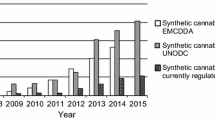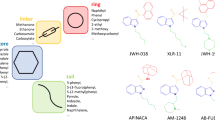Abstract
Purpose
The analysis of products which contain synthetic cannabinoids (SCs) is very challenging due to their diversity and rapidly changing SC structures, variable herbal matrices and, above all, inaccessibility of reference standards. Therefore, the aim of this study was to develop a method which allows quantification of SCs’ contents in herbal blends without their reference standards.
Methods
Identification of SCs was performed using liquid chromatography–high-resolution tandem mass spectrometry with a quadrupole time-of-flight analyser (LC–QTOF-MS/MS). A liquid chromatography–charged aerosol detection (LC–CAD) method with unified calibration for the quantification of SCs was developed and validated. Two available reference standards were used as universal standards. Quantitative analysis using a nuclear magnetic resonance spectroscopy method was also performed to externally validate the developed LC–CAD method.
Results
All peaks of SCs observed in LC–CAD chromatograms were identified by LC–QTOF-MS/MS. Validation data and results from a CAD response evaluation indicated that the elaborated quantitative method was sufficiently accurate for the determination of SCs belonging to various chemical families. The LC–CAD method turned out to be very flexible, because it was successfully applied for the analysis of 19 herbal products.
Conclusions
In this study, methods which enable identification and quantification of currently known SCs as well as novel unknown derivatives without their reference standards were developed. These methods can be applied to the control of suspect SC products and may support the risk assessment of SC presence on the market. To our knowledge, this is the first trial to use LC–CAD for unified quantification of SCs without their reference standards.








Similar content being viewed by others
References
Brents LK, Prather PL (2014) The K2/Spice phenomenon: emergence, identification, legislation and metabolic characterization of synthetic cannabinoids in herbal incense products. Drug Metab Rev 46:72–85. https://doi.org/10.3109/03602532.2013.839700
Fattore L (2016) Synthetic cannabinoids—further evidence supporting the relationship between cannabinoids and psychosis. Biol Psychiatry 79:539–548. https://doi.org/10.1016/j.biopsych.2016.02.001
Dresen S, Ferreirós N, Pütz M, Westphal F, Zimmermann R, Auwärter V (2010) Monitoring of herbal mixtures potentially containing synthetic cannabinoids as psychoactive compounds. J Mass Spectrom 45:1186–1194. https://doi.org/10.1002/jms.1811
Gurney SM, Scott KS, Kacinko SL, Presley BC, Logan BK (2014) Pharmacology, toxicology, and adverse effects of synthetic cannabinoid drugs. Forensic Sci Rev 26:53–78
European Monitoring Centre for Drugs and Drug Addiction (EMCDDA) (2017) Perspectives on drugs. Synthetic cannabinoids in Europe. http://www.emcdda.europa.eu/system/files/publications/2753/POD_Synthetic%20cannabinoids_0.pdf. Accessed 8 July 2017. (update: 06.06.2017)
Archer RP, Treble R, Williams K (2011) Reference materials for new psychoactive substances. Drug Test Anal 3:505–514. https://doi.org/10.1002/dta.317
Choi H, Heo S, Choe S, Yang W, Park Y, Kim E, Chung H, Lee J (2013) Simultaneous analysis of synthetic cannabinoids in the materials seized during drug trafficking using GC–MS. Anal Bioanal Chem 405:3937–3944. https://doi.org/10.1007/s00216-012-6560-z
Znaleziona J, Ginterová P, Petr J, Ondra P, Válka I, Ševčík J, Chrastina J, Maier V (2015) Determination and identification of synthetic cannabinoids and their metabolites in different matrices by modern analytical techniques—a review. Anal Chim Acta 874:11–25. https://doi.org/10.1016/j.aca.2014.12.055
Scheidweiler KB, Huestis MA (2014) Simultaneous quantification of 20 synthetic cannabinoids and 21 metabolites, and semi-quantification of 12 alkyl hydroxy metabolites in human urine by liquid chromatography-tandem mass spectrometry. J Chromatogr A 1327:105–117. https://doi.org/10.1016/j.chroma.2013.12.067
Akamatsu S, Mitsuhashi T (2014) MEKC–MS/MS method using a volatile surfactant for the simultaneous determination of 12 synthetic cannabinoids. J Sep Sci 37:304–307. https://doi.org/10.1002/jssc.201301132
Musah RA, Domin MA, Walling MA, Shepard JRE (2012) Rapid identification of synthetic cannabinoids in herbal samples via direct analysis in real time mass spectrometry. Rapid Commun Mass Spectrom 26:1109–1114. https://doi.org/10.1002/rcm.6205
Gottardo R, Chiarini A, Dal Prà I, Seri C, Rimondo C, Serpelloni G, Armato U, Tagliaro F (2012) Direct screening of herbal blends for new synthetic cannabinoids by MALDI-TOF MS. J Mass Spectrom 47:141–146. https://doi.org/10.1002/jms.2036
Ciolino LA (2015) Quantitation of synthetic cannabinoids in plant materials using high performance liquid chromatography with UV detection (validated method). J Forensic Sci 60:1171–1181. https://doi.org/10.1111/1556-4029.12795
Gamache PH (ed) (2017) Charged aerosol detection for liquid chromatography and related separation techniques. Wiley, Hoboken. https://doi.org/10.1002/9781119390725
Vehovec T, Obreza A (2010) Review of operating principle and applications of the charged aerosol detector. J Chromatogr A 1217:1549–1556. https://doi.org/10.1016/j.chroma.2010.01.007
Poplawska M, Blazewicz A, Bukowinska K, Fijalek Z (2013) Application of high-performance liquid chromatography with charged aerosol detection for universal quantitation of undeclared phosphodiesterase-5 inhibitors in herbal dietary supplements. J Pharm Biomed Anal 84:232–243. https://doi.org/10.1016/j.jpba.2013.06.018
Stojanovic A, Lammerhofer M, Kogelnig D, Schiesel S, Sturm M, Galanski M, Krachler R, Keppler B, Lindner W (2008) Analysis of quaternary ammonium and phosphonium ionic liquids by reversed-phase high-performance liquid chromatography with charged aerosol detection and unified calibration. J Chromatogr A 1209:179–187. https://doi.org/10.1016/j.chroma.2008.09.017
Sun P, Wang X, Alquier L, Maryanoff CA (2008) Determination of relative response factors of impurities in paclitaxel with high performance liquid chromatography equipped with ultraviolet and charged aerosol detectors. J Chromatogr A 1177:87–91. https://doi.org/10.1016/j.chroma.2007.11.035
Lisa M, Lynen F, Holcapek M, Sandra P (2007) Quantitation of triacylglycerols from plant oils using charged aerosol detection with gradient compensation. J Chromatogr A 1176:135–142. https://doi.org/10.1016/j.chroma.2007.10.075
Granica S, Krupa K, Klebowska A, Kiss A (2013) Development and validation of HPLC-DAD-CAD-MS3 method for qualitative and quantitative standardization of polyphenols in Agrimoniae eupatoriae herba (Ph. Eur). J Pharm Biomed Anal 86:112–122. https://doi.org/10.1016/j.jpba.2013.08.006
Rasanen I, Kyber M, Szilvay I, Rintatalo J, Ojanperä I (2014) Straightforward single-calibrant quantification of seized designer drugs by liquid chromatography–chemiluminescence nitrogen detection. Forensic Sci Int 237:119–125. https://doi.org/10.1016/j.forsciint.2014.02.003
Laks S, Pelander A, Vuori E, Ali-Tolppa E, Sippola E, Ojanperä I (2004) Analysis of street drugs in seized material without primary reference standards. Anal Chem 76:7375–7379. https://doi.org/10.1021/ac048913p
Ojanperä I, Mesihää S, Rasanen I, Pelander A, Ketola RA (2016) Simultaneous identification and quantification of new psychoactive substances in blood by GC-APCI-QTOFMS coupled to nitrogen chemiluminescence detection without authentic reference standards. Anal Bioanal Chem 408:3395–3400. https://doi.org/10.1007/s00216-016-9461-8
Ojanperä S, Tuominen S, Ojanperä I (2007) Single-calibrant quantification of drugs in plasma and whole blood by liquid chromatography-chemiluminescence nitrogen detection. J Chromatogr B 856:239–244. https://doi.org/10.1016/j.jchromb.2007.06.005
International Conference on Harmonization (ICH) (2005) Topic Q2 (R1): validation of analytical procedures: text and methodology. www.emea.europa.eu/pdfs/human/ich/038195en.pdf. Accessed 13 Mar 2016
Holzgrabe U, Wawer I, Diehl B (2008) NMR spectroscopy in pharmaceutical analysis, 1st edn. Elsevier, Amsterdam
Malz F, Jancke H (2005) Validation of quantitative NMR. J Pharm Biomed Anal 38:813–823. https://doi.org/10.1016/j.jpba.2005.01.043
McCarthy RS, Gamache PH, Asa DJ, Laws K, Cole RD, Woodcock MJ, Freeto SM (2005) HPLC analysis of non-volatile analytes using charged aerosol detection. LCGC N Am 23:150–161
Gorecki T, Lynen F, Szucs R, Sandra P (2006) Universal response in liquid chromatography using charged aerosol detection. Anal Chem 78:3186–3192. https://doi.org/10.1021/ac060078j
Kavanagh P, Grigoryev A, Savchuk S, Mikhura I, Formanovsky A (2013) UR-144 in products sold via the Internet: identification of related compounds and characterization of pyrolysis products. Drug Test Anal 5:683–692. https://doi.org/10.1002/dta.1456
Kacinko SL, Xu A, Homan JW, McMullin MM, Warrington DM, Logan BK (2011) Development and validation of a liquid chromatography–tandem mass spectrometry method for the identification and quantification of JWH-018, JWH-073, JWH-019, and JWH-250 in human whole blood. J Anal Toxicol 35:386–393. https:doi.org/10.1093/anatox/35.7.386
Bononi M, Belgi P, Tateo F (2011) Analytical data for identification of the cannabimimetic phenylacetylindole JWH-203. J Anal Toxicol 35:360–363. https:doi.org/10.1093/anatox/35.6.360
Denooz R, Vanheugen J-C, Frederich M, de Tullio P, Charlier C (2013) Identification and structural elucidation of four cannabimimetic compounds (RCS-4, AM-2201, JWH-203 and JWH-210) in seized products. J Anal Toxicol 37:56–63. https://doi.org/10.1093/jat/bks095
Behonick G, Shanks KG, Firchau DJ, Mathur G, Lynch CF, Nashelsky M, Jaskierny D, Meroueh C (2014) Four postmortem case reports with quantitative detection of the synthetic cannabinoid, 5F-PB-22. J Anal Toxicol 38:559–562. https://doi.org/10.1093/jat/bku048
Vikingsson S, Josefsson M, Gréen H (2015) Identification of AKB-48 and 5F-AKB-48 metabolites in authentic human urine samples using human liver microsomes and time of flight mass spectrometry. J Anal Toxicol 39:426–435. https://doi.org/10.1093/jat/bkv045
Wurita A, Hasegawa K, Minakata K, Gonmori K, Nozawa H, Yamagishi I, Watanabe K, Suzuki O (2015) Identification and quantitation of 5-fluoro-ADB-PINACA and MAB-CHMINACA in dubious herbal products. Forensic Toxicol 33:213–220. https://doi.org/10.1007/s11419-015-0264-y
Uchiyama N, Matsuda S, Wakana D, Kikura-Hanajiri R, Goda Y (2013) New cannabimimetic indazole derivatives, N-(1-amino-3-methyl-1-oxobutan-2-yl)-1-pentyl-1H-indazole-3-carboxamide (AB-PINACA) and N-(1-amino-3-methyl-1-oxobutan-2-yl)-1-(4-fluorobenzyl)-1H-indazole-3-carboxamide (AB-FUBINACA) identified as designer drugs in illegal products. Forensic Toxicol 31:93–100. https://doi.org/10.1007/s11419-012-0171-4
Shevyrin V, Melkozerov V, Nevero A, Eltsov O, Shafran Y (2013) Analytical characterization of some synthetic cannabinoids, derivatives of indole-3-carboxylic acid. Forensic Sci Int 232:1–10. https://doi.org/10.1016/j.forsciint.2013.06.011
The Drug Enforcement Administration’s Special Testing and Research Laboratory (2016) SWGDRUG monographs. http://www.swgdrug.org/monographs.htm. Accessed 28 Mar 2016
Russell JJ, Heaton JC, Underwood T, Boughtflower R, McCalley DV (2015) Performance of charged aerosol detection with hydrophilic interaction chromatography. J Chromatogr A 1405:72–84. https://doi.org/10.1016/j.chroma.2015.05.050
Shevyrin V, Melkozerov V, Nevero A, Eltsov O, Morzherin Y, Shafran Y (2013) Identification and analytical properties of new synthetic cannabimimetics bearing 2,2,3,3-tetramethylcyclopropanecarbonyl moiety. Forensic Sci Int 226:62–73. https://doi.org/10.1016/j.forsciint.2012.12.009
Tsujikawa K, Yamamuro T, Kuwayama K, Kanamori T, Iwata YT, Inoue H (2014) Thermal degradation of a new synthetic cannabinoid QUPIC during analysis by gas chromatography–mass spectrometry. Forensic Toxicol 32:201–207. https://doi.org/10.1007/s11419-013-0221-6
Acknowledgements
This study was partly supported by a grant from the National Research Centre in Poland (2013/09/B/ST4/00106).
Author information
Authors and Affiliations
Corresponding authors
Ethics declarations
Conflict of interest
The authors declare that they have no conflicts of interest.
Ethical approval
This article does not contain any studies with human participants or animals performed by any of the authors. For this type of study, informed consent is not required.
Rights and permissions
About this article
Cite this article
Popławska, M., Błażewicz, A., Kamiński, K. et al. Application of high-performance liquid chromatography with charged aerosol detection (LC–CAD) for unified quantification of synthetic cannabinoids in herbal blends and comparison with quantitative NMR results. Forensic Toxicol 36, 122–140 (2018). https://doi.org/10.1007/s11419-017-0392-7
Received:
Accepted:
Published:
Issue Date:
DOI: https://doi.org/10.1007/s11419-017-0392-7




